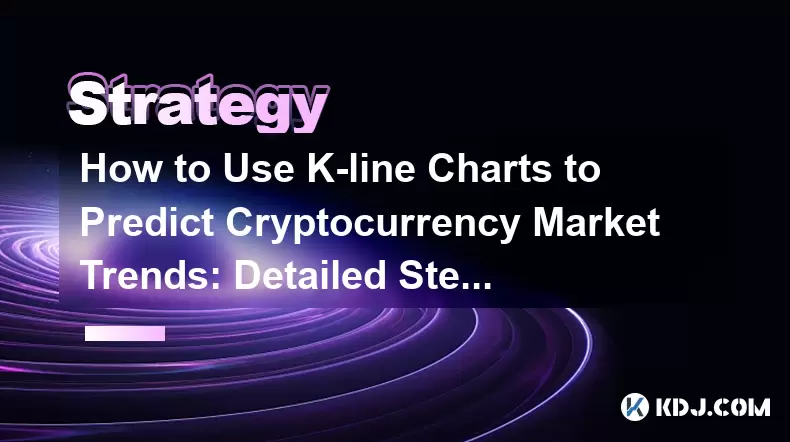-
 bitcoin
bitcoin $114320.977035 USD
-0.40% -
 ethereum
ethereum $4152.439985 USD
-1.75% -
 tether
tether $1.000111 USD
-0.04% -
 xrp
xrp $2.843037 USD
-1.63% -
 bnb
bnb $1013.349380 USD
-1.62% -
 solana
solana $208.362767 USD
-2.10% -
 usd-coin
usd-coin $0.999783 USD
0.00% -
 dogecoin
dogecoin $0.232559 USD
-1.00% -
 tron
tron $0.333491 USD
-1.09% -
 cardano
cardano $0.806310 USD
0.19% -
 hyperliquid
hyperliquid $45.023720 USD
-1.59% -
 ethena-usde
ethena-usde $1.000819 USD
-0.06% -
 chainlink
chainlink $21.241249 USD
-2.11% -
 avalanche
avalanche $30.035416 USD
-0.66% -
 stellar
stellar $0.364984 USD
-2.05%
How to Use K-line Charts to Predict Cryptocurrency Market Trends: Detailed Steps and Techniques
K-line charts visually represent cryptocurrency price movements using candlesticks that show open, high, low, and close prices, helping traders identify trends and potential reversals through patterns like engulfing, hammer, and doji formations.
Jun 16, 2025 at 01:22 am

Understanding the Basics of K-line Charts
K-line charts, also known as candlestick charts, are one of the most widely used tools in cryptocurrency trading for analyzing price movements. These charts provide a visual representation of market sentiment and price action over specific time intervals, such as 1 hour, 4 hours, or daily. Each candlestick represents four key pieces of data: open, high, low, and close (OHLC) prices. The body of the candle shows the range between the open and close, while the wicks or shadows indicate the highest and lowest prices reached during that period.
The color of the candle is crucial for interpretation — typically, a green candle indicates that the closing price was higher than the opening price (bullish movement), while a red candle means the closing price was lower than the opening (bearish movement). Understanding these basic elements allows traders to identify patterns and anticipate potential reversals or continuations in the market.
Identifying Common Candlestick Patterns
Recognizing recurring candlestick patterns is essential for predicting short-term price movements in the crypto market. Some of the most reliable patterns include:
- Bullish Engulfing: A small red candle followed by a larger green candle that completely engulfs the previous candle’s range, signaling a potential reversal from a downtrend.
- Bearish Engulfing: The opposite of the bullish engulfing, where a small green candle is followed by a large red candle, indicating a possible trend reversal from an uptrend.
- Hammer: A candle with a long lower wick and a small body near the top, often seen at the bottom of a downtrend, suggesting a potential bullish reversal.
- Shooting Star: Similar to the hammer but appears at the top of an uptrend, indicating a bearish reversal.
- Doji: A candle with nearly equal open and close prices, reflecting indecision in the market.
Each pattern carries its own implications based on the context of the current trend. Traders should look for confirmation through subsequent candles or volume changes before making decisions based solely on these patterns.
Combining K-lines with Support and Resistance Levels
To enhance predictive accuracy, support and resistance levels should be used in conjunction with K-line analysis. Support is a price level where buying pressure historically outweighs selling pressure, causing the price to bounce upwards. Resistance, conversely, is a level where selling pressure tends to dominate, causing the price to reverse downward.
When a candlestick forms near a significant support or resistance zone, it can offer powerful insights into potential breakouts or rejections. For example, if a hammer candle appears near a strong support level, it may signal a strong likelihood of a price rebound. Similarly, a shooting star forming near a resistance level could indicate that the upward momentum is fading and a pullback is imminent.
Traders can draw horizontal lines to mark these key levels and monitor how price interacts with them in real-time using K-line charts. This method helps filter out false signals and increases confidence in trade setups.
Integrating Volume Analysis with K-line Patterns
Volume plays a critical role in validating the strength of a K-line pattern. High trading volume accompanying a particular candle suggests stronger conviction among market participants. Conversely, low volume may indicate a lack of interest or a potential false breakout.
For instance, a bullish engulfing pattern accompanied by a surge in volume is more likely to result in a genuine trend reversal compared to one that occurs with minimal volume. Similarly, a spinning top or doji appearing during high volume might suggest a major shift in market sentiment is underway.
Many charting platforms allow users to display volume bars beneath the K-line chart. By observing whether volume aligns with the candlestick formations, traders can better assess the validity of a potential move.
Using Timeframes Effectively in K-line Analysis
Choosing the right timeframe is vital when interpreting K-line charts. Shorter timeframes like 5-minute or 15-minute charts can show detailed price fluctuations but are prone to noise and false signals. Longer timeframes such as 4-hour or daily charts tend to provide clearer trends and more reliable patterns.
A common strategy among professional traders involves multi-timeframe analysis. For example, a trader might use the daily chart to determine the overall trend direction and then switch to the 1-hour chart to find precise entry points based on K-line patterns. This approach helps avoid emotional trading and keeps the trader aligned with the dominant trend.
It's important to note that the same candlestick pattern can have different implications depending on the timeframe. A morning star pattern on a 1-hour chart may not carry the same weight as one forming on a weekly chart. Therefore, always consider the broader context before executing trades.
Frequently Asked Questions (FAQs)
Q: Can K-line charts be used for all cryptocurrencies?Yes, K-line charts are universally applicable across all cryptocurrencies. Whether you're analyzing Bitcoin, Ethereum, or any altcoin, the principles of candlestick analysis remain consistent. However, some low-volume or illiquid coins may produce less reliable patterns due to erratic price behavior.
Q: Do I need special software to read K-line charts?No, most modern crypto trading platforms like Binance, Coinbase, or TradingView offer built-in K-line charting tools. These platforms provide customizable settings, including various timeframes, indicators, and drawing tools to assist with technical analysis.
Q: How accurate are K-line predictions in volatile markets?While K-line charts are powerful tools, they are not foolproof, especially in highly volatile conditions. Sudden news events or whale activities can distort normal price action. It's best to combine K-line analysis with other tools like moving averages, RSI, or MACD to improve accuracy.
Q: Should beginners rely solely on K-line charts?Beginners should treat K-line charts as part of their learning toolkit rather than the sole decision-making factor. Gaining experience in reading patterns and understanding market context takes time. Practicing with demo accounts or paper trading can help build confidence without risking real capital.
Disclaimer:info@kdj.com
The information provided is not trading advice. kdj.com does not assume any responsibility for any investments made based on the information provided in this article. Cryptocurrencies are highly volatile and it is highly recommended that you invest with caution after thorough research!
If you believe that the content used on this website infringes your copyright, please contact us immediately (info@kdj.com) and we will delete it promptly.
- BlockDAG, DOGE, HYPE Sponsorship: Crypto Trends Shaping 2025
- 2025-10-01 00:25:13
- Deutsche Börse and Circle: A StableCoin Adoption Powerhouse in Europe
- 2025-10-01 00:25:13
- BlockDAG's Presale Buzz: Is It the Crypto to Watch in October 2025?
- 2025-10-01 00:30:13
- Bitcoin, Crypto, and IQ: When Genius Meets Digital Gold?
- 2025-10-01 00:30:13
- Stablecoins, American Innovation, and Wallet Tokens: The Next Frontier
- 2025-10-01 00:35:12
- NBU, Coins, and Crypto in Ukraine: A New Yorker's Take
- 2025-10-01 00:45:14
Related knowledge

Practical parameter settings for a Bitcoin multi-timeframe moving average system
Sep 18,2025 at 10:54pm
Optimizing Timeframe Combinations for Bitcoin Trading1. Selecting appropriate timeframes is crucial when building a multi-timeframe moving average sys...

How can I filter out false breakouts in Dogecoin high-frequency trading?
Sep 22,2025 at 01:00am
Understanding False Breakouts in Dogecoin Trading1. A false breakout occurs when Dogecoin's price appears to move beyond a defined support or resistan...

Techniques for identifying tops and bottoms in the Bitcoin on-chain NVT model
Sep 20,2025 at 07:54pm
Understanding the NVT Model in Bitcoin Analysis1. The Network Value to Transactions (NVT) ratio is often described as the 'P/E ratio' of the cryptocur...

What does the surge in open interest in Bitcoincoin futures mean?
Sep 20,2025 at 11:18pm
Understanding the Surge in Dogecoin Futures Open Interest1. A surge in open interest within Dogecoin futures indicates a growing number of active cont...

How can I use the Ethereum USDT premium to gauge market sentiment?
Sep 18,2025 at 11:55pm
Understanding the Ethereum USDT Premium1. The Ethereum USDT premium refers to the price difference between USDT (Tether) traded on Ethereum-based plat...

What should I do if Ethereum staking yields decline?
Sep 20,2025 at 06:18am
Understanding the Causes Behind Declining Ethereum Staking Yields1. The Ethereum network transitioned to a proof-of-stake consensus mechanism with the...

Practical parameter settings for a Bitcoin multi-timeframe moving average system
Sep 18,2025 at 10:54pm
Optimizing Timeframe Combinations for Bitcoin Trading1. Selecting appropriate timeframes is crucial when building a multi-timeframe moving average sys...

How can I filter out false breakouts in Dogecoin high-frequency trading?
Sep 22,2025 at 01:00am
Understanding False Breakouts in Dogecoin Trading1. A false breakout occurs when Dogecoin's price appears to move beyond a defined support or resistan...

Techniques for identifying tops and bottoms in the Bitcoin on-chain NVT model
Sep 20,2025 at 07:54pm
Understanding the NVT Model in Bitcoin Analysis1. The Network Value to Transactions (NVT) ratio is often described as the 'P/E ratio' of the cryptocur...

What does the surge in open interest in Bitcoincoin futures mean?
Sep 20,2025 at 11:18pm
Understanding the Surge in Dogecoin Futures Open Interest1. A surge in open interest within Dogecoin futures indicates a growing number of active cont...

How can I use the Ethereum USDT premium to gauge market sentiment?
Sep 18,2025 at 11:55pm
Understanding the Ethereum USDT Premium1. The Ethereum USDT premium refers to the price difference between USDT (Tether) traded on Ethereum-based plat...

What should I do if Ethereum staking yields decline?
Sep 20,2025 at 06:18am
Understanding the Causes Behind Declining Ethereum Staking Yields1. The Ethereum network transitioned to a proof-of-stake consensus mechanism with the...
See all articles










































































